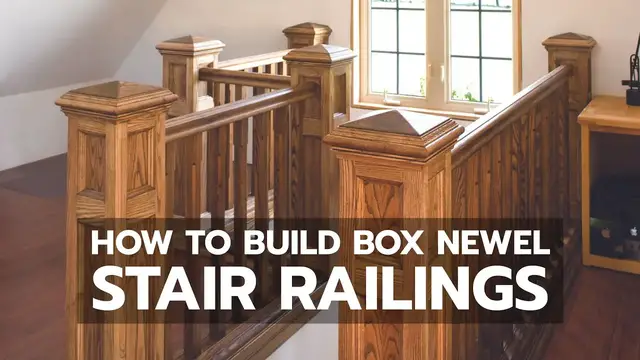Watch this 10-minute tour of a classic box newel stair railing designed and built by cabinetmaker Steve Maxwell. Solid cherry construction, see all the details Steve used to make this classic piece of millwork.
READ MY POPULAR ARTICLES ABOUT:
Polyurethane Finish - https://bit.ly/powerbuffing
DIY Hoop House Plans - https://bit.ly/hoophouseplans
Submersible Pump Installation - https://bit.ly/pumpinstallation
Air-Drying Wood Tips - https://bit.ly/wooddrying
How to Build a Table - https://bit.ly/tablebuilding
How to Stain a Deck - https://bit.ly/deckstain
Choosing Waterproof Outdoor Glue - https://bit.ly/exterioradhesives
How To Build A Wheelchair Ramp - https://bit.ly/wheelchairrampplans
SUBSCRIBE: http://bit.ly/BLRchannel
WATCH MY POPULAR VIDEO: How to Cut Perfect Miter Joints
https://youtu.be/0wnjJ-Xi5FU
WATCH MORE BAILEY LINE ROAD:
Winter Tips - https://bit.ly/2rpnUcm
Show More Show Less View Video Transcript
0:00
I've been working on a box new staircase railing and I'm coming to the end of the
0:14
project now. Before I fasten everything in place I thought you might appreciate
0:19
seeing how it goes together. It might help you with a project in mind that you
0:23
have and it just shows the design that I came up with and some of the advantages
0:28
especially in terms of how solid it is. That's one of the reasons I like box
0:33
new staircase railings is because they are so solid. It gets the name from this
0:38
new post here. It's a box with some panels here and this side has been
0:45
secured. It's glued and this is permanently installed and it's quite strong. The only movement in it is the actual flexing of this box. There's
0:54
no wiggling on the bottom at all. Before I assemble the other side with glue
1:00
let me show you how it goes together and you can see what you think
1:04
I'm going to start by lifting off this box newel here and the first thing I
1:10
want to show you is how this newel fastens to the floor. This is a sandwich
1:16
of plywood that I've made. It's about three inches high I think and it's
1:22
glued and secured to the floor with these structural screws so it's not
1:27
going anywhere. There's a floor joist that runs here so these screws sink into
1:33
that. These just sink into the plywood subfloor but the whole thing is fastened
1:37
with glue and what that allows me to do is drive some screws through the side of
1:44
the box newel into this base piece and that really adds a lot of strength
1:50
You can see some of the screw holes that I have here. I'll be driving
1:57
screws in there as a final step. I'm also going to put a lot of glue around here
2:02
so it kind of seeps down into the gap between the box newel and this
2:07
anchor block. What's going on here is the railing. Let's see if I can get it apart
2:16
here for you. So the railing, I should say everything has been made from
2:25
rough lumber. Inch thick, inch and a half, two inch. This railing I milled. You can
2:33
see here it's laminated. The lamination mark is in the finger groove
2:38
here and this profile was created with three different router bits. There's the
2:46
router bit that forms the top part. There's another router bit that I use to
2:50
form where your fingers grab and then a chamfer bit along the bottom. This groove
2:57
underneath nestles into where the where these spindles go and then later when
3:04
everything's together I will be putting thin pieces of wood between the spindles
3:10
But if you go down here you can see how how these spindles fit in with things
3:19
The base of the railing is made with this 1 3 quarter inch thick base
3:26
piece. This railing is made of cherry. You can do this sort of work with any kind
3:32
of hardwood and you can see here there's a half inch hole to accept a dowel and
3:39
then the spindle goes on top. Well at the bottom of this hole I don't suppose you
3:44
can see it too well but at the bottom of this hole there's a wood screw. So this
3:49
base piece that you see here is fastened to the subfloor with glue and then one
3:55
screw in each of the dowel holes that run along the length. Now over here
4:02
you've got separate pieces of trim. One on this side and one on the other side
4:07
and that creates the channel within which the spindles fit. So it contains
4:14
them from side to side and when I add these blocks it creates a kind of a
4:21
square mortise within which the spindle fits and it's quite solid. When I glue
4:28
this when I put it all together finally I'm going to use weld bond glue in here
4:33
because I have a finish on this surface and weld bond is one of the only glues
4:37
that can stick to a finish. I'm just going to use regular high strength
4:41
cabinetmakers glue for all the other joints but that's the way this bottom
4:47
part goes together with the base, the side moldings, the dowels for the spindles and
4:53
then these blocks that flank the spindles and form a kind of a base. So here we
5:00
have the railing. I've taken it off you can see underneath the half inch dowel
5:04
holes. Cut this groove with a dado blade on the table saw and as I said there's
5:09
going to be spacers of wood just a little bit higher than flush with the
5:14
bottom of the railing that further secures the top of the spindles. You'll
5:20
notice here the spindles are numbered with a certain arrow direction and
5:27
that's because each spindle is the holes for it are specifically drilled
5:35
for that spot. I've been as accurate as I could and you know in practice you can
5:40
actually interchange some of these but just to be sure that the holes line up
5:45
properly and that the blocks at the bottom are tight to the spindles I just
5:51
number everything and then I can be sure it's going to go together properly. So
5:55
the assembly procedure will be to glue the bottoms of the spindles with their
6:01
blocks to slather some glue on top here some glue into the holes and then to put
6:07
the railing back on and the railing is held to the newel post with some more of
6:14
these structural screws. These are great they have a big beefy thread on them a
6:19
nice big head they hold like crazy so the holes here in the railing correspond
6:26
with holes that I've drilled here in the newel post. I used some dowel centers to
6:31
transfer the holes properly and then the structural screws just just go inside
6:38
and I have a right angle drill which lets me tighten that up and pulls it all
6:47
together and I just leave it alone for a day and it's as solid as a rock so
6:52
that's the design overview I hope you find it useful maybe you can make a
6:57
staircase railing like this yourself. So just before I finish up here I've got the final assembly done everything's
7:15
solid I wanted to show you about the the newel caps that I've made I built them
7:20
as a separate assembly and this piece of plywood here fits inside the newel post
7:27
there's a little bit of slack there moving around a bit my plan is to put
7:34
some silicone caulking around here just to act as an adhesive not a permanent
7:38
adhesive but one that's just going to to keep this solid and then what I'm
7:45
gonna finish up with is installing some trim around here I've done this sort of
7:51
work before and I've always fastened the trim to the newel cap but I think this time I'm gonna try fastening it to the actual newel so this is going to be
7:59
solid although I can lift this off if I ever need to I've allowed a little bit
8:08
of space here it's a dry time of the year where I am now I've allowed a little bit of space around the pyramid cap so that it can expand in the
8:17
summertime if need be I don't think there's any way around that but I just
8:21
would like to be able to remove this in case anything happens this I can take
8:25
off it's not glued and then the pyramid cap is also not glued it's held with
8:31
screws driven through oversized holes so that it can expand and contract a
8:36
little bit one last thing I had a challenging situation here this sloped
8:42
roof this is an attic this is a finished attic situation and the sloped roof was
8:47
getting in the way I was really trying to figure out how I could do this I didn't want to lower the railing so much and the newel post that it wouldn't hit
8:56
the roof so what did I end up doing was just making a regular newel cap and
9:03
cutting it off to fit just slicing it on the table saw sanding and smooth
9:08
getting the angle right angling the top corner of the newel post and it just
9:16
kind of fits in here and it looks like it's sprouting out of the attic roof
9:21
thanks for watching click here to join the thousands of people who get the
9:26
Bailey line road hands-on how-to newsletter for free every Saturday morning
#Crafts
#Home Improvement
#Construction & Power Tools
#Building Toys



